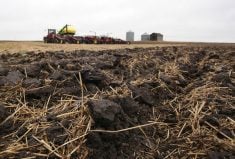The global pipeline for kabuli chickpeas is empty, according to a trader of the crop.
One of the big reasons is that India had a short crop in 2022-23, Navneet Singh Chhabra, director of Global Garbanzo, said during the Global Pulse Confederation’s India Roundtable webinar.
He estimates current stocks are no more than 20,000 to 25,000 tonnes and new crop supplies won’t start to arrive for two to three months.
Read Also

Fertilizer method’s link to emissions studied
A researcher says others studying greenhouse gas emissions aren’t considering how the loss of nitrogen into the atmosphere correlates with fertilizer application or if there is an impact to yield.
Prices are high, which is limiting consumption of the crop in India and abroad. Large calibre kabulis are selling for US$1,550 to $1,600 per tonne.
India is an exporter of kabuli chickpeas, so Canada has one less competitor, at least for the next few months. Seeding of the new crop is now underway in India and will proceed through December.
Chhabra anticipates acreage will be up 50 percent over last year’s levels. Seeding has been proceeding nicely in the main producing states of Maharashtra, Madhya Pradesh and Andhra Pradesh.
He expects markets to remain firm and even appreciate another $100 per tonne during the first two months of the new crop year, which begins in April, and then settle down around June as supplies are bolstered.
The other important kabuli market to watch is Mexico, said Chhabra.
Roberto Perez, commercial manager of PURP, a pulse and grain trader in Sinaloa, Mexico, recently told GPC there could be a shortfall of Mexican chickpeas and beans this year.
“In Sinaloa, chickpea seedings were around half of what they were last year, mostly due to producers having decided to seed corn,” he said in a Nov. 17 GPC article.
Perez said the last medium-to-large size chickpeas that PURP sold went for US$1,350 to $1,400 per tonne.
“A scarcity could put those prices up by $200 or $300,” he said.
While India produces and exports some kabuli chickpeas, it is the world’s largest producer and consumer of desi chickpeas.
Gaurav Jain, analyst with AgPulse Analytica, estimates that India produced 13.5 million tonnes of both types of chickpeas in 2022-23. Ending stocks of the desis are predicted to be “humongous” at 3.3 million tonnes, with most of that being held by the National Agricultural Cooperative Marketing Federation of India Ltd. (NAFED), a government procurement agency.
He believes overall chickpea acreage will be down in 2023-24, reducing production to 12.15 million tonnes. However, ending stocks will still be robust at three million tonnes.
Chickpea market prices are below the government’s minimum support price, so farmers will likely switch to rapeseed, wheat and lentils.
G. Chandrashekhar, senior editor of The Hindu Business Line, said Jain is using the government’s official production estimate number, but he believes that is optimistic.
He believes 2022-23 production is closer to 11 million tonnes. Chandrashekhar also thinks India will fall short of the 2023-24 government target of 12.15 million tonnes.
Saurabh Bhartia, head of Glencore Agriculture India, said it is undeniable that desi chickpeas will lose acres this year to the tune of a six to eight percent decline. He believes those acres will go to wheat and mustard.
Bhartia expects desi chickpea consumption to be similar to last year. The drop in production will be offset by high government stocks, so he anticipates the market will be sideways.
Contact sean.pratt@producer.com


















